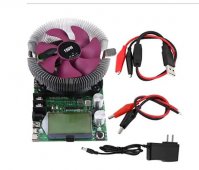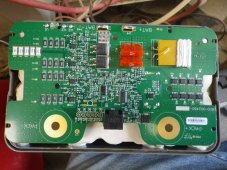TeresaMust
New Member
- Joined
- Jun 11, 2021
- Messages
- 4
Any information or help would be greatly appreciated and sorry, in advance for the long message!!!
I have two ironworks medical cart batteries purchased on eBay for $140 each. The Iron Works company is no longer in business so I don’t know much about them. I have them connected in parallel and I am trying to figure out if their BMS needs to be communicating with each other in order to charge them completely with a lithium charger and to use a 500/1000 watt PSW inverter with them connected in parallel.
I Tested them each with a 300 watt inverter and a 50 watt load attached and they ran for 9.45 hours and each delivered very close to 48 amps.
I have a custom made truck camper with two group 27 SLA batteries, 200 watts of solar a 140 amp alternator attached to a voltage sensitive relay that charges the SLA batteries and a 1500 watt HarborFreight inverter.
I run two roof Fantastic Fans, a 1.7 cu foot 110 volt dorm fridge, a few minutes of 750 watt microwave , charge two phones and run a few LED lights. The 180 amps of SLA batteries sometimes struggles to keep up on days when it is cloudy or days I do not drive the truck.
I have made a battery pack , inside an Ammo box with the ironworks batteries and a 300 watt MSW inverter. I have Connected the SLA batteries to the ironworks pack through a fused Renogy DC to DC, 20 amp charger and it is working well to charge up the Ironworks batteries but I am wondering about their limitations. I have a lithium charger to charge the pack when I have shore power
I connected all the camper 12 volt stuff (Fantastic Fans, lights) to the Ironworks pack so that the SLA batteries run only the Fridge and occasional microwave use through the Harbor Freight Inverter.
I was wondering if I could connect a bigger inverter (say 500/1000 watts) to the paralleled ironworks to have a backup for the fridge. Will the individual BMS’s shut the inverter down?
I did try to attach an Everstart Walmart 750 watt inverter that I had lying around to thetwo Ironworks in Parallel and the inverter would not start up. Might be the inverter… not sure.
I am trying to not spend a lot of money but just might buy a Bestec 500/1000 and give it a try.
I messaged a member privately who has used these batteries and he gave me some great info but suggested I post my question here as well.
Sorry again for such a long message!!!!
I have two ironworks medical cart batteries purchased on eBay for $140 each. The Iron Works company is no longer in business so I don’t know much about them. I have them connected in parallel and I am trying to figure out if their BMS needs to be communicating with each other in order to charge them completely with a lithium charger and to use a 500/1000 watt PSW inverter with them connected in parallel.
I Tested them each with a 300 watt inverter and a 50 watt load attached and they ran for 9.45 hours and each delivered very close to 48 amps.
I have a custom made truck camper with two group 27 SLA batteries, 200 watts of solar a 140 amp alternator attached to a voltage sensitive relay that charges the SLA batteries and a 1500 watt HarborFreight inverter.
I run two roof Fantastic Fans, a 1.7 cu foot 110 volt dorm fridge, a few minutes of 750 watt microwave , charge two phones and run a few LED lights. The 180 amps of SLA batteries sometimes struggles to keep up on days when it is cloudy or days I do not drive the truck.
I have made a battery pack , inside an Ammo box with the ironworks batteries and a 300 watt MSW inverter. I have Connected the SLA batteries to the ironworks pack through a fused Renogy DC to DC, 20 amp charger and it is working well to charge up the Ironworks batteries but I am wondering about their limitations. I have a lithium charger to charge the pack when I have shore power
I connected all the camper 12 volt stuff (Fantastic Fans, lights) to the Ironworks pack so that the SLA batteries run only the Fridge and occasional microwave use through the Harbor Freight Inverter.
I was wondering if I could connect a bigger inverter (say 500/1000 watts) to the paralleled ironworks to have a backup for the fridge. Will the individual BMS’s shut the inverter down?
I did try to attach an Everstart Walmart 750 watt inverter that I had lying around to thetwo Ironworks in Parallel and the inverter would not start up. Might be the inverter… not sure.
I am trying to not spend a lot of money but just might buy a Bestec 500/1000 and give it a try.
I messaged a member privately who has used these batteries and he gave me some great info but suggested I post my question here as well.
Sorry again for such a long message!!!!






